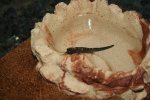salsalami
New member
- Joined
- Dec 11, 2012
- Messages
- 5
- Reaction score
- 0
- Points
- 0
- Country
- United States
Hi, we're new to the forum and new salamander owners. We've had our yellow spotted salamander for a couple of months now, and it doesn't eat. We found it in the backyard a couple of months ago, took it to the vet (who told us it was very small and that its chances of survival were not very good, but that they were better with us than in the wild at this time of year, so we decided to keep it) and he told us to hand feed it "carnivorous powder" with an oral syringe. We also bought mealworms and during the first week he ate two (we gave them to him with tweezers). He hasn't wanted to eat them since. We keep hand feeding him, but I think his mouth is starting to get hurt from our opening it (we carefully do it with our pinky nail, but still).
We've kept our salamander alive for about two months this way, and want to do everything we can to give it a long life. Any ideas on what to give him and how? The first week we had him (before going to the vet) we gave him baby crickets, but he didn't eat any. The vet told us he's too small to eat crickets.
He lives in a 10 lb tank at about 68F, we keep the substrate (sphangum moss) humid and he has a pool, a rock, a cork, and a fake plant.
Thanks!
We've kept our salamander alive for about two months this way, and want to do everything we can to give it a long life. Any ideas on what to give him and how? The first week we had him (before going to the vet) we gave him baby crickets, but he didn't eat any. The vet told us he's too small to eat crickets.
He lives in a 10 lb tank at about 68F, we keep the substrate (sphangum moss) humid and he has a pool, a rock, a cork, and a fake plant.
Thanks!

